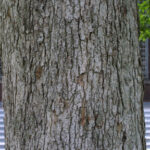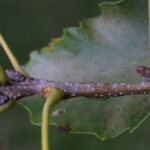Scientific Name:
Quercus muehlenbergii
Description:
- The leaf base is typically more rounded.
- The veins and sinuses are regular.
- Acorns on short stalks and turn chestnut brown in the fall.
- The leaves have sharp teeth but no bristles, as a member of the white oak subgenus of Quercus.
Chinkapin oak is monoecious in flowering habit; flowers emerge in April to late May or early June. The staminate flowers are borne in catkins that develop from the leaf axils of the previous year, and the pistillate flowers develop from the axils of the current year’s leaves. The fruit, an acorn or nut, is borne singly or in pairs, matures in 1 year, and ripens in September or October. About half of the acorn is enclosed in a thin cup and is chestnut brown to nearly black.
Chinkapin oak is closely related to the smaller but generally similar dwarf chinkapin oak (Quercus prinoides). Chinkapin oak is usually a tree, but occasionally shrubby, while dwarf chinkapin oak is a low-growing, clone-forming shrub. The two species generally occur in different habitats: chinquapin oak is typically found on calcareous soils and rocky slopes, while dwarf chinkapin oak is usually found on acidic substrates, primarily sand or sandy soils, and also dry shales.
Chinkapin oak is also sometimes confused with the related chestnut oak (Quercus montana), which it closely resembles. However, unlike the pointed teeth on the leaves of the chinkapin oak, chestnut oak leaves generally have rounded teeth. The two species have contrasting kinds of bark: Chinkapin oak has a gray, flaky bark very similar to that of white oak (Q. alba) but with a more yellow-brown cast to it (hence the occasional name yellow oak for this species), while chestnut oak has dark, solid, deeply ridged bark. The chinkapin oak also has smaller acorns than the chestnut oak or another similar species, the swamp chestnut oak (Q. michauxii), which have some of the largest acorns of any oaks.
Range and Habitat:
The chinquapin oak is native to eastern and central North America, ranging from Vermont west to Wisconsin and south to South Carolina, western Florida, New Mexico, and northeastern Mexico from Coahuila south to Hidalgo.
Chinkapin oak is generally found on well-drained upland soils derived from limestone or where limestone outcrops occur. Occasionally it is found on well-drained limestone soils along streams. The Chinkapin oak is generally found on soils that are weakly acid (pH about 6.5) to alkaline (above pH 7.0). It grows on both northerly and southerly aspects but is more common on the warmer southerly aspects. It is absent or rare at high elevations in the Appalachians.
It is rarely a predominant tree, but it grows in association with many other species. It is a component of the forest cover type White Oak-Black Oak-Northern Red Oak (Society of American Foresters Type 52) and the Post Oak-Blackjack Oak (Type 40) (2). It grows in association with white oak (Quercus alba), black oak (Q. velutina), northern red oak (Q. rubra), scarlet oak (Q. coccinea), sugar maple (Acer saccharum), red maple (A. rubrum), hickories (Carya spp.), black cherry (Prunus serotina), cucumbertree (Magnolia acuminata), white ash (Fraxinus americana), American basswood (Tilia americana), black walnut (Juglans nigra), butternut (J. cinerea), and yellow-poplar (Liriodendron tulipifera). American beech (Fagus grandifolia), shortleaf pine (Pinus echinata), pitch pine (P. rigida), Virginia pine (P. uirginiana), Ozark chinkapin (Castanea ozarkensis), eastern redcedar (Juniperus virginiana), bluejack oak (Quercus incana), southern red oak (Q. falcata), blackgum (Nyssa sylvatica), and winged elm (Ulmus alata) also grow in association with chinkapin oak. In the Missouri Ozarks a redcedar-chinkapin oak association has been described.
The most common small tree and shrub species found in association with chinkapin oak include flowering dogwood (Cornus florida), sassafras (Sassafras albidum), sourwood (Oxydendron arboreum), eastern hophornbeam (Ostrya virginiana), Vaccinium spp., Viburnum spp., hawthorns (Crataegus spp.), and sumacs (Rhus spp.). The most common woody vines are wild grape (Vitis spp.) and greenbrier (Smilax spp.)
Chinkapin oak is classed as intolerant of shade. It withstands moderate shading when young but becomes more intolerant of shade with age. It is regarded as a climax species on dry, drought prone soils, especially those of limestone origin. On more moist sites it is subclimax to climax. It is often found as a component of the climax vegetation in stands on mesic sites with limestone soils. However, many oak-hickory stands on moist sites that contain chinkapin oak are succeeded by a climax forest including beech, maple, and ash.







